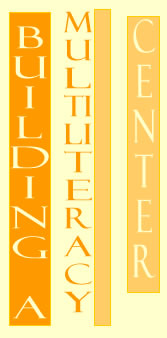

Building
from a Writing Center Model
KHM: Prior
to your work in creating the
Multiliteracy Center within the Sweetland Writing Center, the University
of Michigan did not have a unit on campus that brought together different
departments specifically to think about multimodal writing and new media
literacy practices. Tell
us how you generated the design for your Multiliteracy Center.
DS: As we wrote up the proposal for the Multiliteracy Center, I tried to look at a variety of sources that were published. Although I don't think that there's a lot written specifically on how writing centers can support multimodal composition. I think that is still yet to be explored extensively.
You
can tell from the name of the center, the Multiliteracy Center, that we
looked at a short article by John Trimbur, "Multiliteracies,
Social Futures, and Writing Centers,"
published in the Writing Center Journal ( v.20 n.2 p.29-32 Spring/Summer
2000) that uses the concept of multiple literacies and that talks about
writing centers redefining themselves as Multiliteracy Centers. Although,
I think that we originally came to the concept of multiple literacies
through the famous article that was collaboratively authored by the New
London Group, which outlines a whole pedagogy of multiliteracies. (New
London Group. (1996). A pedagogy of multiliteracies: Designing social
futures. Harvard Educational Review, v.66 n.1 p.60-92 Spring 1996.)
Along
with that researching and theorizing, we also looked at what was going
on at other schools. Clemson
and Furman Universities
both have facilities that do something similar to what we wanted to do.
We knew James Inman and I talked to him about his goals in designing and
establishing the facility at Furman. (see Inman, James. (2001). At
First Site: Lessons from Furman University’s Center for Collaborative
Learning and Communication. academic.writing. http://wac.colostate.edu/aw/
articles/inman2001/)
I had also visited Michigan
Tech's humanities computing lab, which really, in some ways, sets
the standards for a multimodal authoring facility. I tried to draw on
the experience and the concepts that were demonstrated in all of these
facilities, and a few other ones like the units that were at the University
of Michigan itself, and take what I could from each of these. I don't
think there's anything that's precisely like the Multiliteracy Center
at Michigan, but there are other places where students can get help with
composing a web page. It's not the same kind of help, and it's not delivered
in the same way, but it's still one-on-one support.
We were working specifically from a writing center model. The Multiliteracy Center is offered through the Sweetland Writing Center, and it takes place in the writing center, through people who have been trained in some version of a writing center pedagogy program. And so, that was our starting point. Not very many support units across the country and no other support units at University of Michigan begin with that model -- a model that focuses on a particular understanding of peer tutoring, a so-called non-directive approach, where the peer becomes a facilitator, who really keeps the student composer very active in the composing process. With the non-directive approach, you're talking about something that's the opposite of the teacher who says, do it this way, change this, revise this. The opposite of the red pen approach, where you circle things that need to be changed or you cross things out that need to be deleted.
KHM: And the opposite of how technical support services would offer assistance for building anything in a web format?
DS:
That's right. Most technical support services, as their names imply, start
with the technology. They say, "You want to use Dreamweaver for this
if it's a web project, and here's what you do. You pull up Dreamweaver,
and you start a new document, and you set the page properties, and here's
what it means to compose in html, etc., etc." And, we don't start
there. We might cover that at some point in the process. But we start
with your rhetorical goals: What is the message that you hope to communicate?
Who is your target audience? What is the purpose for communicating this
message? We integrate the technology into the composing process that begins
with those rhetorical questions. So that makes us a little bit different
from other technical support units on campus and across the country. We
work from that writing center model. And, we're committed to it and we
believe in its effectiveness.
Top | Next